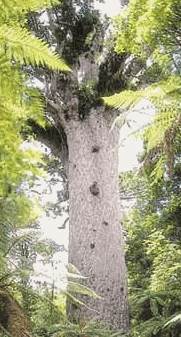 Kauri. Cowrie. Gum Kauri. Australian Copal.
Kauri. Cowrie. Gum Kauri. Australian Copal.
The image on the left is of Tane Mahuta the Lord of the
Forest. This magnificent presence is to be found in the Waipoua
Forest Northland. A photograph cannot reveal that, which must be
experienced.
So great was
the demand for the timber and the gum products
of Agathis australis that one author reported that between 1871 and
1882 some 47,407 imperial tons of recent and fossilised gum was
removed from the soil, and further stated, that it had been
estimated that it would take the forest growth of 10,000 years to
replace it. The great Kauri forests of old were decimated almost to
the point of extinction. They are now protected.
The following has been condensed from the US Dispensatory, 1926.
Kauri Gum
is an
amber like substance, varying from a soft cream-white to an amber
color, dug in large quantities from the soil of Australia and New
Zealand. It is a resinous exudation from the Kauri Spruce, Agathis
australis Salisb. (Dammaris australis Lamb.), of the Fam. Coniferae,
but, as it first exudes, and is found on the surface of the ground,
it is not esteemed.
The useful resin is a fossil deposit, found
especially in New Zealand swamps, at depths of from 2 to14 feet. The
production of kauri is largely carried on under governmental supervision.
The resin appears in pieces ranging in size from that of a hen's egg to a
man's head, of a pale greenish- yellow color and with a balsamic odor.
Baume Caledonien.
Consists of a solution of Kauri gum in an equal weight of 90 % alcohol.
It. has been used with alleged great success in the treatment of wounds
and ulcers, of eczema and other skin affections, and as a substitute for
collodion and the soluble sodium silicate. When applied to a well
cleansed and dried wound it, leaves a slight deposit of resin as a
varnish, which is not affected by friction or contact with water.
This preparation is invaluable .. 90% v/v alcohol is
rectified spirit .. real spirit .. rectified Brandy .. a 1:1 extract. Take a
1 or 2 litre bottling jar that has a rubber seal and take care that no
alcohol or the extract touches the seal. The alcohol must be weighed as
must the gum .. in this way the correct ratio of the
preparation is maintained. Crush the Kauri Gum with a hammer and add it by the
tablespoon to the alcohol .. swirling as you go. Seal, then store the
product in a cool dark place for a minimum of 7 days .. swirl it daily ..
at the end of 7 days examine the extract and if you have done it correctly,
at the bottom of the jar will be seen a rubbery mass and possibly bits of
debris .. the coagulated mass is the gum which has been separated
from the resin .. the resin is dispersed through the clear liquid ..
carefully decant the extract into its final storage bottle .. discard the
debris.
The commercial product known as Manila copal, according to
Tschirch and Koch, is derived from Agathis Dammara. (Dammora orientalis
Lamb.), a conifer. It consists chiefly of free amorphous resin acids,
namely, alpha. and beta. mancophalolic acid, Cl0Hl2O2
about 80 %. and contains besides that about 12 % of a resin, C20H32O2,
and about five per cent of essential oil. The latter, when fresh, forms
a liquid as clear as water, very mobile, having a pleasant odor, and
with an SG of 0.840; it boils at from 165 to 1700E
C, and mixes in all proportions with alcohol, ether, chloroform and
fatty oils.
It is still possible to find small bags of fossilized resin
some of which is sold in curio shops and brings a price commensurate with its
scarcity. The more recent resins may be collected as congealed tears at the
base of kauri trees and if correctly cleaned by making them liquid, then
straining them to remove bits of bark and earth and even the odd insect then
one may make a perfectly useful preparation that does the task.
New Zealand Bush Medicine
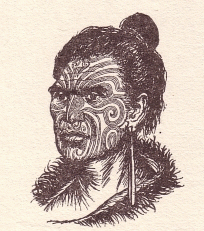
|
Common
Name |
Botanical
Name |
Part Used |
|
Aka or Aka kura |
Metrosideros
fulgens |
Sap from the stem. |
|
Akatea. |
Metrosideros
albiflora |
Sap from inner
bark |
|
Angiangi |
Lembophyllum
clandestinum |
Bruised moss |
|
Harakeke
|
Phormium tenax |
Root and leaf base
gum |
|
Horopito
|
Pseudowintera
axillaris |
Leaves. |
|
Kahikatea
|
Dacrycarpus
dacrydioides |
Leaves |
|
Kanuka |
Kunzea ericoides |
Leaves |
|
Kareao |
Ripogonum scandens |
Root |
|
Karamu
|
Copromosa robusta |
Leaves, shoots,
inner bark |

|
Kauri |
Agathis australis |
Gum |
|
Koromiko |
Hebe salicifolia |
Leaves and shoots |
|
Kumerahou |
Pomaderris
kumeraho |
Leaves |
|
Kawakawa |
Macropiper
excelsum |
Leaves |
|
Kowhai |
Sophora
microphylla |
Bark |
|
Mingimingi |
Cyathodes juniperina |
Leaves |
|
Nikau |
Rhopalostylis
sapida |
Pith and sap |
|
Patete |
Schefflera
digitata |
Leaves and sap |
|
Pohutakawa |
Metrosideros
excelsa |
Inner bark |
|
Ramarama |
Lophomyrtus
bullata |
leaves |
|
Rangiora |
Brachyglottis
repanda |
Gum and leaves |
|
Rata |
Metrosideros
robusta |
Bark |

|
Rewarewa |
Knightia excelsa |
Inner bark |
|
Rimu |
Dacrydium cupressinum |
Leaves and sap |
|
Tarata |
Pittosporum eugenioides |
Bark, gum and leaves |
|
Tataramoa |
Rubus cissoides |
leaves |
|
Tawa |
Beilschmiedia tawa |
Bark |

|
Tawapou |
Planchonella novo zelandia |
Oil from boiled berries |
|
Ti Kauka |
Cordyline australis |
leaves, shoots and stems |
|
Toatoa |
Haloragis erecta |
Juice and leaves |
|
Toetoe |
Cortaderia fulvida and spp. |
Plumes and resin |
|
Totara |
Podocarpus totara
|
Bark and berries |

|
Tutu |
Coriaria arborea |
Leaves |
|
Tutumako |
Euphrasia cuneata |
Herb |
|
Tutunawhai |
Polygonum decipiens |
Herb |
|
Waiuatua |
Euphorbia glauca |
Herb |
|
Waoriki |
Ranunculus amphitrichus |
herb and juice |
|
Wharangi |
Melicope ternata
|
Gum |
|
Wharariki |
Phormium cookianum |
Leaves |
Therapeutic Action of Selected NZ Plants
|
Abortifacient |
Harakeke - Karaeo - Tataramoa. |
|
Alterative |
Karaeo - Karamu - Kawakawa
- Kumerahou - Patete. |
|
Analgesic |
Akatea - Horopito - Nikau - Pukatea. |
|
Anthelmintic |
Harakeke. |
|
Antiperiodic |
Koromiko. |
|
Antiseptic |
Aka - Mingimingi - Patete -
Ramarama - Toatoa. |
|
Antitussive |
Aka - Kumerahou - Tataramoa. |
|
Astringent |
Kanuka - Koromiko - Rata - Totara. |
|
Calmative |
Manuka - Nikau. |
|
Carminative |
Karamu - Kawakawa - Tataramoa. |
|
Depurative |
Kawakawa - Kumerahou. |
|
Diuretic |
Kanuka - Kawakawa -
Koromiko - Kumerahou. |
|
Emmenagogue |
Akatea - Mingimingi. |
|
Emollient |
Harakeke - Kauri - Rangiora
- Rewarewa. |
|
Expectorant |
Kumerahou - Tatatamoa. |

|
Febrifuge |
Horopito - Kanuka - Totara. |
|
Galactagogue |
Ti Kauka. |
|
Haemostatic |
Angiangi - Pohutakawa - Tataramoa. |
|
Laxative |
Nikau - Tataramoa. |
|
Narcotic |
Kawakawa - Pukatea. |
|
Pectoral |
Kumerahou - Mingimingi |
|
Resolvent |
Ramarama. |
|
Sedative |
Nikau |
|
Stimulant |
Horopito |
|
Stomachic |
Harakeke - Karamu -
Koromiko |
|
Vulnerary |
Kauri - Rata - Rimu - Toatoa. |
To the memory of the old Pakeha bushmen, loggers, gum diggers and gold
fossickers. Not for them the genteel ways of position and privilege. For
it was upon the sweat of their brow and the strength of their backs that
much of the wealth of New Zealand was built.
Rough and oft times unlettered, hard drinking, loud cussing men.
Yet amongst them, those versed in language, music and philosophy. One in
particular, Bill Lord of Waiheke Island. His stories of the old days
in the hinterlands of the Bay of Plenty held my children in thrall. He
could look at a Constellation and say � ah yes in the Autumn it will
rise there � and in the Spring over there�. Dear old Bill, what an
education you were.
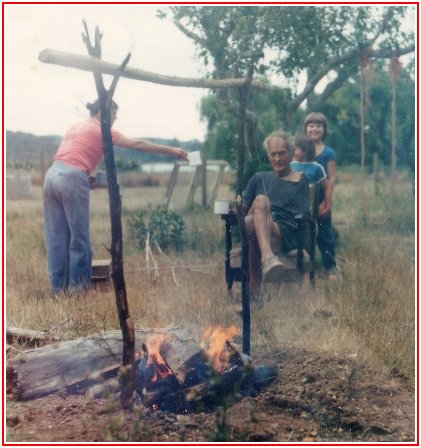
Other New Zealand monographs which may be of
interest .. The Lichens of NZ .. New
Zealand Tea Tree.
A little more on Bill Lord is to be found
here .. The Tale of Two
Williams.

|

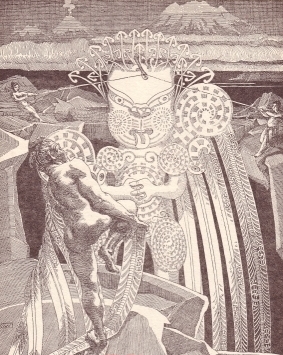 New Zealand and Botanic Materia Medica
New Zealand and Botanic Materia Medica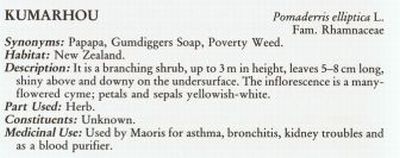
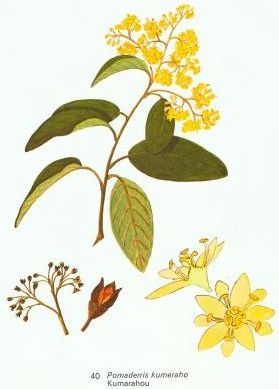 The
Botanical image on the left was painted by Audrey Eagle and
produced from 'Eagles 100 shrubs and climbers of New Zealand.
The
Botanical image on the left was painted by Audrey Eagle and
produced from 'Eagles 100 shrubs and climbers of New Zealand.
 Kauri. Cowrie. Gum Kauri. Australian Copal.
Kauri. Cowrie. Gum Kauri. Australian Copal.
